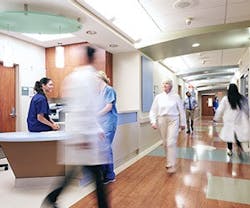How Population Health Principles are Changing Hospital FM Strategies
In much the same way that doctors and nurses use real-time data to monitor patients’ vital signs, hospital FMs are increasingly using sophisticated sensors embedded in equipment to track the health of their “patient” – the HVAC system.
Data-driven decisions are a cornerstone of population health management, which uses patient data to guide strategies to improve individuals’ health at the lowest necessary cost. A population health model is ideal for facilities management, explains Pete Bulgarelli, Executive Managing Director of JLL Corporate Solutions.
“Hospitals are using data to identify and track high-risk and at-risk patients, but few have a technology platform to help them manage the part of their business that represents 40% or more of the assets on their balance sheets,” Bulgarelli says. “If hospitals applied a population health management model to their real estate and facilities, they would reduce the risk associated with aging equipment and infrastructure and keep them performing at a high level.”
Five areas of FM in particular are a good fit for a population health model, according to a new JLL report:
1) Patient safety and satisfaction. Use technology to track routine maintenance orders through mobile devices that allow FMs to prioritize, assign, execute and track the work orders’ progress. Analyzing work order data can also shine a light on recurring problems with people, processes or equipment, helping identify opportunities for operational efficiency and candidates for retrofits or replacement.
2) Life safety. Hospitals and health systems have started using an automated approach to regulatory compliance, the report explains. For example, analytics can show the percentage of failed life safety elements to better understand the condition and maintenance of buildings. Automating these processes makes it easier to proactively address life safety codes and regulations, which not only improves compliance, but also enhances safety.
3) Environmental equipment. Sensors can continuously track performance and transmit data in real-time, eliminating the need to do manual spot checks to assess equipment health. Analyzing that data lets users anticipate when equipment might fail and take action accordingly.
4) Medical equipment. RFID tags make it easy to keep an accurate inventory of medical equipment and its location so that physicians can ensure the right equipment goes to the right room. “Smart” medical equipment that utilizes the Internet of Things to talk to other equipment without human intervention can transmit location and performance data.
5) Space utilization. FMs can pull up color-coded floor maps and select filters to view spaces by several variables. This information enables informed decisions on the most effective and efficient use of space, such as choosing the closest available diagnostic testing area to a patient’s room.
